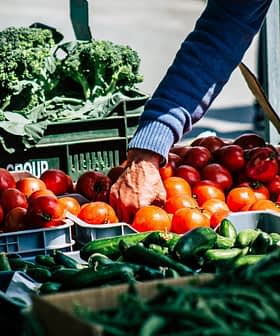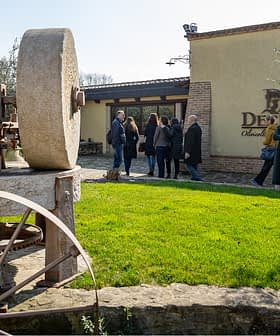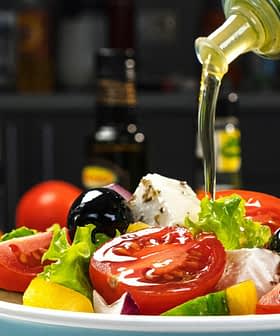Reading the articles by Athan Gadanidis on the decreasing prices of olive oil in Greece and the country’s failure to fully exploit its rich olive oil resources brought to mind a meal enjoyed among hillsides covered with olive groves last spring at the Dounias Taverna or “Traditional Center of Gastronomy of the Cretan Diet,” in Drakona, Crete.
At the Dounias Taverna, the owners cook with olive oil from their trees which beautifully complements their own fresh, home-grown produce and meats as well as other local products cooked over a wood fire and baked in their wood-burning oven.
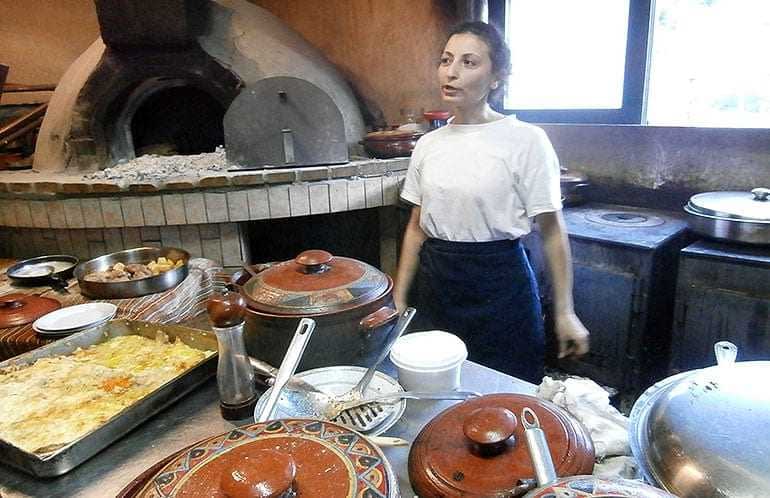
Dounias Taverna
Such creative, healthy cooking can encourage customers, including an American who has lived in Crete with her Greek husband for the last twelve years, to both embrace the Cretan diet at home and appreciate restaurants like this which are dedicated to it.
Inspired by tasty food and countless articles detailing the benefits of the traditional Mediterranean diet, including copious amounts of olive oil, many decide to change their diet and cooking. This American searched for olive-oil based healthy recipes, learned from local Cretan cooks, experimented with extra virgin olive oil in everyday dishes, and began to prefer the small, family-run Cretan restaurants which are also dependent on it.
The exquisite, ancient gold headpieces that mimic olive wreaths in Greek museums captivate viewers at first sight, but an American’s conversion to the Cretan diet may occur more gradually. After all, the traditional Cretan diet provides quite a contrast to the typical diet many Americans grew up with, and large numbers still consume foods like hamburgers, hot dogs, steak, pork chops, macaroni and cheese, spaghetti, processed meats, and soft white bread. Even those who eat plenty of salads and fresh fruit might also drink soft drinks and frequently enjoy cookies, donuts, cakes, and pies rich in butter, margarine, or shortening. However, the Americans who feel nostalgic enough for those desserts to bake them on holidays may still come to realize they can manage without butter and processed food for everyday cooking and baking.
One such conversion to the Cretan diet began during a mid-thirties pregnancy, shortly after a move to Crete. Avoiding processed foods and eating plenty of fresh fruits, vegetables, and whole grains was fairly easy on this agricultural island where people tend to cook from scratch, using fresh, often local, ingredients. It was harder to develop a taste for fresh fish (served with the head and tail!) and boiled wild greens (horta) with oil and lemon, but not impossible. While it can initially seem very strange for an American to eat salads, vegetables, or bread with strong-tasting extra virgin olive oil, one can gradually become accustomed to the taste and even come to savor it. A visiting Canadian in search of butter could not find any in the house, because olive oil is used for almost all cooking, baking, salads, and bread dipping in his converted cousin’s Cretan-American kitchen.

Fish for sale at the farmers’ market in Chania
Those convinced to change their diet may search for healthier alternatives, for example in Micki Sannar’s attractive Olive Oil Desserts cookbook, which features some tasty but also very sweet desserts. The olive oil pie crust there is an excellent alternative to one made with solid fats, and it’s easy to add less sugar to the apples than advised. Internet searches on foodferret.com, which allows users to list ingredients to include (e.g. olive oil, whole wheat flour) and to exclude (butter, sugar) reveal recipes for healthier muffins and cookies made with olive oil as well as countless other foods.
A wonderful, just slightly sweet olive oil cookie can be adapted from an online recipe rich in orange juice and olive oil. And Greeks have known all along how to make excellent cakes with olive oil and yogurt, but no butter. Brown rice or bulgur is tasty when cooked with olive oil, garlic, bay leaves, and a bit of salt, and traditional Greek recipes for “ladera,” or olive-oil rich, lentils, beans, cauliflower, or green beans, among other things, are easy to follow as well as healthy.
Many of the large resort hotels on Crete may need to resort to frozen meals during their high season (according to the owner of a small family-run taverna outside Chania), but there are still plenty of families on the island who cook with fresh ingredients from their own gardens or farms. A favorite is Kyria (Mrs.) Maria’s Sunset Restaurant next to Tersanas Village Apartments in Horafakia, where one can enjoy freshly baked pastitsio, moussaka, chicken, hamburgers, giant beans, stuffed grape leaves (dolmades), greens, mushroom pie, and salads on the spacious terrace overlooking the sea from May through October.
Another family has turned a burnt hillside into the gorgeous Botanical Park of Crete, a natural wonderland amidst foothills of olive groves that is full of both exotic and local plants. They use their own organic produce in the increasingly popular restaurant that mixes traditional Cretan tastes with beautiful, tasty innovations including or accompanied by olive oil.
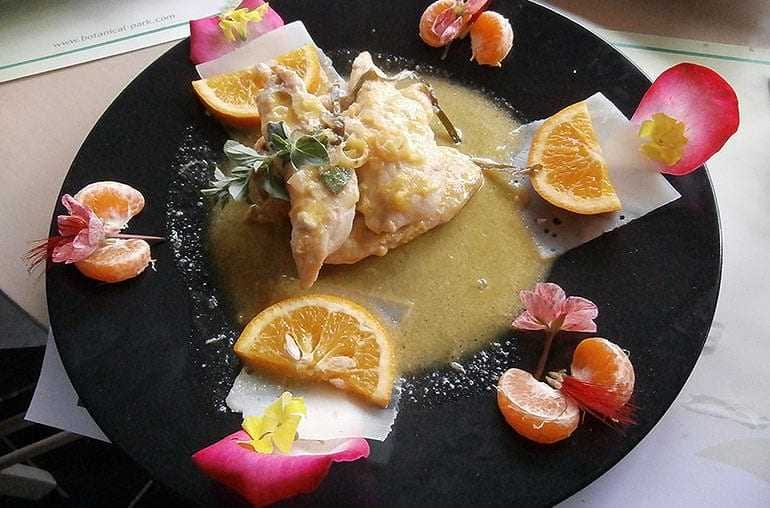
Botanical Park chicken dish garnished with flowers and citrus
Also in the foothills of Crete’s White Mountains, Dounias Taverna’s excellent reputation keeps it busy on many a Sunday afternoon, even in the winter. Sitting on the patio overlooking the olive groves in warmer weather, or squeezed into two small rooms when it’s cold, customers savor meals with unique twists, such as a rich cauliflower dish with coarse wheat and cheese, spanakopita with whole wheat crust, and tzatziki and boureki made with unusual ingredients rather than the typical cucumber or zucchini.
When it isn’t too busy, customers are invited into the kitchen to see the dishes of the day firsthand, in pots on the stove, just coming out of the large, dome-shaped wood-burning oven, or arrayed on a countertop across from it. And before the end of the meal, the owner, Stelios, has a habit of bringing out additional dishes to try — even after the kids have left to follow his son on a tour of their farm, visiting rabbits, olive groves, gardens, and a cow, and grownups have declared themselves too full to eat more!
The Greek olive oil industry may not be doing as good a job marketing its products as the Italian industry, but the personal, local, small-scale touch of hard-working Cretan families offers hope that visitors to Crete can gradually be persuaded to enjoy a traditional Cretan diet featuring high quality, extra virgin olive oil.


